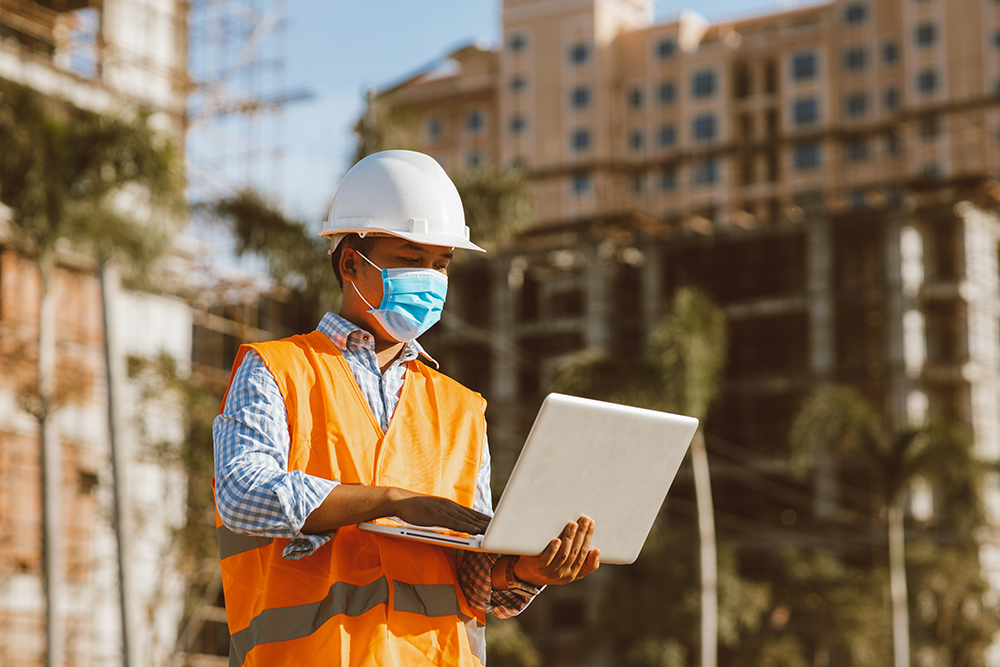
We all want to get back to “normal” and leave COVID-19 behind, but we can’t ignore that it’s brought some smart and helpful changes. Here are seven improvements we’ve seen over the past year that can continue to help construction companies adapt and succeed in a safer and brighter tomorrow.
Table of Contents
According to USA Today, there were over 65,000 flu cases during the 2019 season, but only 1,016 reported during what would have been the 2020 flu season. That’s a 98.4% decrease in cases, and it owes a lot of credit to the adoption of more stringent hygiene and sanitization measures.
In addition to wearing masks, staying six feet apart, and refraining from borrowing other people’s tools, there are other jobsite and office habits from the pandemic — ones that you might want to carry over. Continue cleaning commonly-used services, providing easy access to soap and hand sanitizer, and being more aware of how we spread germs.
Many workers in the construction industry are reluctant to call out sick for minor illnesses like the common cold. They simply muddle through it — but they put their own health (and safety) at risk and will likely infect a few others in the process, leaving you with a team of workers who are under the weather, less alert, and less productive.
During COVID-19, many companies adopted more lenient policies for calling in sick, whether paid or unpaid, that encouraged team members to stay home if they felt they were coming down with something. Calling in sick became less about oneself and more about protecting others — and staying home as a precautionary measure is something you should encourage going forward.
If you normally work in the office at your construction company, you likely spent some time working remotely in 2020. You’ve probably worked out many of the issues you faced in the beginning and started adjusting to the new work environment.
Now that teams are experienced in working from home — and have proven to be just as productive, if not more so — construction companies should be more flexible in allowing their office employees to work remotely on occasion. Whether it’s for bad weather, kids home from school on a workday, or a minor illness, the barriers to spending the day working from the comfort of your home are much less than they used to be.

Did you adopt new software during 2020? If you did, you’re not alone. In 2019, ENR reported that, compared to other industries, construction has been slower to digitize processes. The challenges of the pandemic, however, forced many companies who were hesitant before to adapt quickly to new technology.
Making the initial switch to digital can be an adjustment, but many companies have now cleared that hurdle and are reaping the benefits. If you’re seeing increased efficiency and accuracy because of your new software, continue using it post-pandemic and evaluate what other processes you can simplify through technology.
Zoom meetings — they’ve become a part of everyone’s vernacular during the past year, and they’ve allowed your team to meet without having to be all in one place. Why not allow it to continue making your life a little simpler?
Sure, Zoom meetings might never permanently replace in-person meetings with coffee, donuts, and bagels (and we wouldn’t want them to), but for quick questions, touch-bases, and meetings team members would normally have to drive out of their way (and away from their job sites) to get to, video calls are a great solution.
Prior to the pandemic, you probably used some sort of cloud storage to keep all of your team-wide or company-wide files in one place and accessible to everyone. You probably did this mostly to allow multiple computers in the office to access all the files, and to ensure that everything was properly backed up.
But during COVID-19 shutdowns, it became more necessary to complete your work in the Cloud, where multiple team members can work on the same project and all changes are saved and stored securely online. Working in the Cloud doesn’t just make working from home simpler; it also streamlines your work in the office and makes collaboration easier.
Prefab and modular construction have been gaining popularity for a while for their efficiency in both time and money. During the pandemic, however, building with elements constructed off-site allowed contractors to complete the same work with fewer people in shorter amounts of time.
Continuing to embrace modular construction might be in many construction companies’ best interests going forward, as building demand continues to rebound and the industry-wide skilled labor shortage continues. Prefabricated structures often cost less, all while allowing you to complete more work in less time and with fewer people.
It’s been a long and stressful year, and the construction industry deserves to come away with some positive changes from the pandemic. What changes will you be adopting for good?
If you’d like more information on how you can use technology to gain a competitive edge, check out our free industry report, The Case For Digital: Seven Reasons You Should “Paper Proof ” Your Pre-Construction Process.